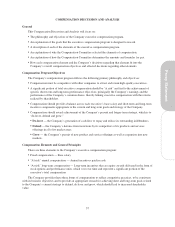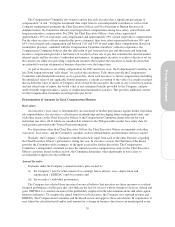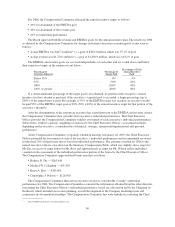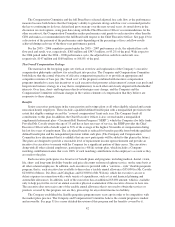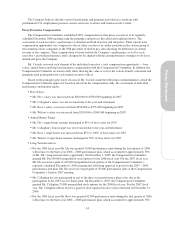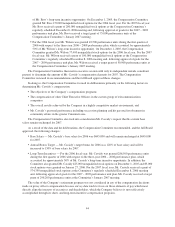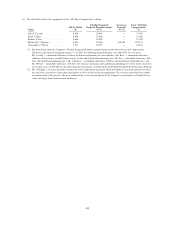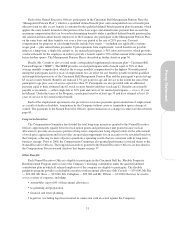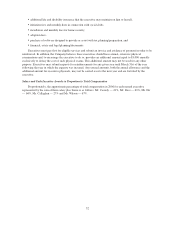Cincinnati Bell 2006 Annual Report Download - page 54
Download and view the complete annual report
Please find page 54 of the 2006 Cincinnati Bell annual report below. You can navigate through the pages in the report by either clicking on the pages listed below, or by using the keyword search tool below to find specific information within the annual report.The Compensation Committee and the full Board have selected adjusted free cash flow as the performance
measure because both believe that the Company’s ability to generate strong cash flow over a sustained period is
the key to continuing its de-lever, defend and grow strategy over the next several years. As noted above in the
discussion on stock options, using peer data (along with the Chief Executive Officer’s recommendations for the
other executives), the Compensation Committee makes performance unit grants to each executive other than the
CEO and makes a recommendation to the full Board with respect to the Chief Executive Officer. See page 43 for
a discussion of the payment of the performance units depending on the percentage of free cash flow results
achieved during each year of the three-year performance period.
For the 2005 – 2006 cumulative period under the 2005 – 2007 performance cycle, the adjusted free cash
flow goal and result, was, respectively, $365 million and $347.5 million, or 95.2% of the goal. With respect to
the 2006 period under the 2006 – 2008 performance cycle, the adjusted free cash flow and result, was,
respectively, $147 million and $160 million, or 108.8% of the goal.
The Overall Compensation Package
The material on the foregoing pages sets forth an overview and explanation of the Company’s executive
compensation philosophy and how it is actually put into practice. The Company and Compensation Committee
both believe that the central objective of effective compensation practice is to provide an appropriate and
competitive mixture of base pay (the “fixed cost” of the program) combined with incentive compensation
programs intended to create fair incentives to each executive that promotes achievement of current year goals and
longer-term business strategy in a way that is complimentary to each other and closely aligned with shareholder
interests. Over time, short- and long-term objectives/strategies may change, and the Company and the
Compensation Committee will make changes in the various elements of compensation that they believe are
responsive to these changes.
Benefits
Senior executives participate in the same pension and savings plans as all other eligible salaried and certain
non-union hourly employees. These include a qualified defined benefit plan with a nonqualified provision to the
extent that eligible earnings exceed the “covered compensation” limit each year. The Company funds all
contributions to this plan. In addition, the Chief Executive Officer is also covered under a nonqualified
supplemental retirement plan – Cincinnati Bell Pension Program (“SERP”), which the Company also fully funds.
Provided Mr. Cassidy attains the age of 55 and has at least ten years of service, the SERP provides the Chief
Executive Officer with a benefit equal to 50% of the average of the highest 36 months of compensation during
his last five years of employment. The calculated benefit is reduced for benefits payable from both the qualified
defined benefit plan and the nonqualified provision within such plan. (The Company and Compensation
Committee have determined that it is unlikely that any new participants will be added to this plan in the future.)
The plans are designed to provide a reasonable level of replacement income upon retirement and provide an
incentive for executives to remain with the Company for a significant portion of their career. The executives,
along with all other salaried employees, participate in a 401(k) savings plan, which includes a Company
matching contribution feature that vests 100% of such matching contributions in the employee’s account as they
are made to the plan.
Each executive participates in a broad set of benefit plans and programs, including medical, dental, vision,
life, short- and long-term disability benefits and price discounts on home telephone service, on the same basis as
all other salaried employees. In addition, each executive is provided with a “cafeteria – style” flexible perquisite
program; that is, each executive has available to him or her a taxable annual allowance ($35,000 for Mr. Cassidy;
$23,000 for Messrs. Dir, Ross and Callaghan; and $13,000 for Mr. Wilson), which the executive can use to
defray expenses in connection with a wide variety of expenditures, such as tax and financial planning and
automobile allowances. In addition, each of the executives has an additional $3,000 amount, which is available
only to help pay for the cost of an annual executive physical examination if the executive chooses to have one.
The executive does not receive any of the taxable annual allowance that is not used to obtain the services or
products covered by this program, nor are they grossed up for any related income tax liability.
The Company established the flexible perquisite program many years ago in order to be competitive with
the market place practice. The Company and Compensation Committee believe the current program is modest
and reasonable. See page 51 for a more detailed discussion of this program and the benefits covered by it.
42







